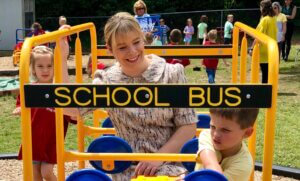By Birmingham News editorial board
The front-line fighters in the war on crime have a plea for policy-makers: Put more money up front, where it will do the most good.
That is, invest in high-quality prekindergarten and save money on future prison and crime costs.
“You can either spend more on the front end for education, or more on the back end for prisons,” said Jefferson County District Attorney Brandon Falls.
The evidence makes the case beyond a shadow of a doubt.
“Pay Now or Pay Much More Later,” a report released Thursday by the nonpartisan, anti-crime group Fight Crime: Invest in Kids, offers persuasive evidence. The group has more than 5,000 law-enforcement officials as members, including dozens from Alabama. Its report details research that followed children over decades. Among the results:
A study of the Chicago Child-Parent Centers, an early education program that has served 100,000 3- and 4-year-olds, found that at-risk children who did not take part were 70 percent more likely to be arrested for a violent crime by the age of 18. And by the age of 26, children who did not get pre-K education were 27 percent more likely to have been arrested for a felony and 39 percent more likely to have been jailed or imprisoned compared to children who received high-quality pre-K.
A similar long-term study showed that children left out of the High/Scope Perry Preschool in Ypsilanti, Mich., were five times more likely to be chronic offenders with five or more arrests by age 27. By the age of 40, those who didn’t attend were 86 percent more likely to spend time in jail or prison.
For each child who drops out of school, uses drugs and becomes a criminal, the lifetime cost to society is, on average, $2.5 million, according to the report. The Ypsilanti program also showed that those who attended the preschool were 44 percent more likely to graduate from high school.
So, there is definitely money to be saved for society by investing up front in high-quality prekindergarten. The Child-Parent Centers program in Chicago produced more than $10 for every dollar spent, according to the report, while the High/Scope Perry Preschool program saved taxpayers more than $16 on crime and other costs for every $1 invested.
Falls and other law-enforcement officials from Alabama, including Jefferson County Sheriff Mike Hale and Birmingham Police Chief A.C. Roper, want to see more of those kind of savings come to the state. In April, they wrote U.S. Sen. Richard Shelby, R-Ala., urging him to support legislation that would increase federal spending on early education programs. Shelby is the ranking member of the Senate Appropriations Subcommittee on Labor, Health and Human Services, Education and Related Agencies.
“As law enforcement leaders who have watched too many kids grow up to become criminals, we urge you to prioritize these investments shown by research to give kids the right start in life and help keep them on track while saving taxpayers money,” the lawmen wrote.
Alabama also needs to increase its investment in prekindergarten. The state is ripe for huge savings, but only if it is willing to spend more money up front.
Alabama has one of the best pre-K programs in the country in First Class, which has met all 10 quality benchmarks set by the National Institute for Early Education Research for six years running. Yet, only 6 percent of Alabama’s 60,000-plus eligible 4-year-olds are enrolled. Another 16 percent of Alabama children attend federally funded Head Start programs.
State government spent $17.6 million on pre-K education in 2011, just a fraction of what it spent feeding, housing and guarding its criminals. Funding for corrections was $605 million in 2011 — 34 times more than what Alabama spent preparing its 4-year-olds for school and life. On average, states spend nine times more on prisons than pre-K, according to the “Pay Now or Pay Much More Later” report.
First Class is yet another example of how we can do great things, but we aren’t willing to pay for them. (The best example is probably the acclaimed Alabama Reading Initiative. It took a decade just to get the program into all K-3 schools, even as other states copied the initiative and education officials credited it for the historic gains in reading by fourth-graders on the National Assessment of Education Progress.)
First Class has grown even more slowly. Funding over the past several years has barely held its own. Supporters considered level funding in next year’s budget a success.
State officials must do more.
A March report by NIEER done for the Alabama School Readiness Alliance’s pre-K task force showed that Alabama over the next decade could grow First Class to reach 70 percent of eligible 4-year-olds at a cost (in today’s dollars) to state government of $125 million more than what it spends now. That would bring high-quality prekindergarten to 43,000 4-year-olds — likely all of the children who would take advantage of it, the report said. Other 4-year-olds would stay at home or attend private-school programs.
The total cost to provide near-universal prekindergarten in Alabama would be $200 million more than is spent now and include fees from parents, local, state and federal funding, and private donations.
By spending $12 million more in state dollars each year over the next decade, the payoff for Alabama could be at least $2 billion and maybe as much as $3.4 billion, NIEER Director Steve Barnett, who did the cost report, has said.
Yes, the state’s economy still lags. Yes, state budgets remain in crisis. And yes, many state government agencies have been battered by cuts over the past several years.
But we still must find a way to invest more in Alabama’s future, not just to save money, but to ensure it will be a good future for more children.
Alabama can “Pay Now or Pay Much More Later.” The evidence for paying now is so strong, the governor and Legislature must not ignore it. They must find a way to grow First Class from a tiny, high-quality prekindergarten program into one that maintains its standards while managing to reach all the state’s 4-year-olds who are likely to use it.
If they do, the state and its children will reap a huge dividend. If they don’t, the state and its children — and its taxpayers — will continue to pay the cost.







